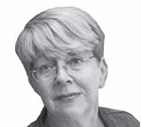
TERRY BIBO
They yelled. They pounded their fists on the table. They locked horns verbally, if not physically.
You think watching local government is boring? Not necessarily.
“There were many meetings it was hard to keep quiet,” said Cheryl Budzinski, longtime observer for the League of Women Voters of Greater Peoria.
But that’s the deal. The League is political, yet non-partisan. Its Local Government Observers (LOGO) are not supposed to be part of the process. They may not be reporters, but they are instructed to be objective, stick to the facts — and remain silent.
“We’re observers,” emphasized former League of Women Voters of Illinois President Jan Dorner. “We’re not watchdogs.”
With actual journalistic watchdogs in short supply, Dorner is helping LWVIL train members in hopes of doubling down on the number of public bodies observed. That’s almost a literal double-down, in the case of the local League. This fall, LWVGP adds the Peoria Park District, Peoria Public Schools, Dunlap Community Unit School District 323 and Tri-County Regional Planning Commission to its list of local government bodies. That’s in addition to the Peoria City Council, Peoria County Board, Peoria County Election Commission, Peoria City/County Landfill Committee, Peoria Housing Authority and Springdale Cemetery Management Authority.
The effort is a corollary to the maxim that all politics is local. News coverage of politics and government needs to be local as well. Editing and reporting from elsewhere doesn’t cut it, even when well-intentioned. Mid-September news that GateHouse Media consolidated its Tazewell County weeklies doesn’t help.
For example, when LWVIL held its third training session in Peoria this past August, Dorner and co-presenter Barbara Laimins seemed puzzled at the high value placed on staffing the meetings of a cemetery. They didn’t know the history: Springdale is not only listed on the National Register of Historic Places. It isn’t worthy just because it was rescued from the brink of disaster by the work of many, many (local) volunteers. It is also a unique hybrid — a combined effort of the city, county and park district — underwritten with public money.
Once explained, they understood the importance. Peoria’s new Observer corps formed the largest contingent of the Leagues being trained here in August. Attendees got a three-hour course on how to cover a meeting, from the League’s point of view. It included information on “sunshine laws” like the Freedom of Information Act and Open Meetings Act. That sounds intimidating, but trainers distilled things down to basics.
Advice was practical: Stick to the facts. Use the agenda and materials, which should be available. (If they aren’t, that’s another issue, which should be referred to your local board for further discussion.) You can, and probably should, record the meetings. Use actual quotes, not a personal interpretation. Have someone who wasn’t present at the meeting review your report to prevent bias.
More observers are needed. (You must be a League member.) Budzinski would like to see coverage expand to include the city councils in East Peoria, Pekin and Washington. The Tazewell County Board could use some observation, and there are many school districts to cover outside Peoria and Dunlap.
For more information, check lwvgp.org.

Recent Comments